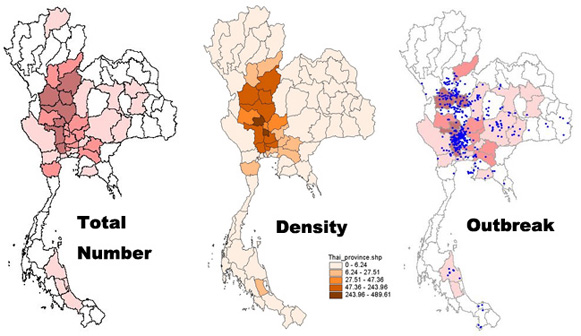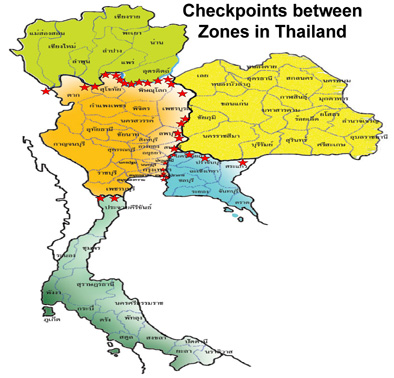|
| Surveillance & Monitoring (ROUTINE or Continuous measure)
Active Surveillance:
- HPAI Case Definition established for clinical observation & early detection and revised for better sensitivity
- Sampling (tracheal/faecal swabs or serum) methods by epidemiological significance (at risk/statistically)
- Migratory & wild birds, especially aquatic bird
- Routine activity, once the outbreak occur
Passive Surveillance (laboratory surveillance):
- Potentially clinical & dead bird samples submission
- Diagnosis & confirmation or to rule out HPAI
AI Case Definition Revision
- Broad signs to discover all AI potential cases
- AI Case Definition and further Revision
a) Severe respiratory signs with excessively watery eyes & sinusitis, cyannosis of the
combs, wattle and shanks, edema of the head, ruffled feathers
b) Diarrhoea and nervous signs
c) Sudden death of almost 100% or approximately cumulative death up to 40% in 3 days
without any noticeable signs
- Poultry death ?10% within a day (July Re-occurrence)
- If any one criterion is observed, disease control measures will be immediately executed.
Active Surveillance Protocol
- The first nationwide active surveillance was conducted during 19-31 January 2004. There were 75,625 samples that 161 cases were found in 71 districts of 40 provinces.
- In the second round (11 February - 4 March 2004), by cloacal swab in 5 km radius from the infected premises. There were 10,046 samples collected that 18 cases were detected in 11 provinces, including a new one (Roi-et).
- In the third round by clinical observation and sampling 11 cases in 9 districts of 8 provinces including 1 new province (Ayudthaya).
- Situaion during 23 January and maintained to 2 July 2004, Totally 190 cases in 89 districts of 42 provinces
- After poultry stamping-out at the infected farms & premises in the surrounding area of 5 km radius
movement control in the affected province
- During which the active surveillance was conducted in a surrounding area within a province of the infected farms/premises
- Specific sampling protocols differently implemented in the infected or control & surveillance zones.
|
A Proactive Measure on Active Surveillance during 1-31 October 2004
- Matching the "Revised HPAI Case Definition" criteria
- Immediate stamping-out with 75% compensation, paid from the Emergency Provincial Trustfund
- No need to wait for any laboratory confirmatory result
- Complete control measures promptly implemented according to the HPAI guidelines
Low HPAI Prevalence
Regions 3-4-5-7-8-9: the sampling of cloacal swabs and sera were collected from 300 farms and 150 flocks/holdings/villages excluding all flocks of traditional duck/goose raising, in each region as follows.
1.1 Total 150 meat-type and breeders of chicken and duck farms : 20 birds from each farms. 1.2 Total 150 egg-type of chicken and duck farms : 20 birds from each farms.
1.3 Total 150 flocks/holdings/villages from other type of poultry i.e. fighting cocks,
bantams, native chicken and pet birds : 20 birds from each farm/ flock/ holding/ village.
(NB:- 20 serum sample will be collected from each farm or village whereas 5 cloacal
swabs from 5 birds can be pooled together in 1 transport medium tube).
1.4 Additionally, 60 ducks/geese from each of traditional duck/goose raisings, and of all
flocks will be collected for 12 cloacal swabs (i.e. 5 birds or swabs can be pooled
together in 1 viral transporting medium tube) and only 15 serum samples.
High HPAI Prevalence
Regions 1-2-6: Sampling would be focussed on the high incidence of HPAI areas,
2.1 That 20 poultry from each village in the listed districts of these 3 regions were
collected for (4 tubes of) cloacal swabs and (20) serum samples.
2.2 Also, other 60 ducks/geese from each of traditional duck/goose raisings and of all
flocks in the regions will be collected for 12 cloacal swabs (5 birds or swabs can be
pooled together in 1 viral transporting medium tube) and only 15 serum samples.
Expectation
- At least 70,500 sera and 65,200 cloacal swab samples would be collected for this proactive nationwide sampling,
- Excluding all those samples from:
movement purposes
all traditional duck/goose raising flocks
native poultry and pet birds registration
HPAI Surveillance & Monitoring
- Active surveillance to be conducted nationwide once the HPAI occurred for monitoring H5 & H7
- Sampling methods & surveillance protocol to be revised accordingly (EU Directives, OIE Code & FAO Expert Consultation Recommendations)
Flock prevalence (1%)
Within flock prevalence (25%)
Confidence Interval (95% or 99%)
Sampling Protocol: Normal Situation
- Flock prevalence is 1% (95% Confidence interval, of both OIE and EU recommendations)
- At the infinity herd population, 300 sampling herds needed by a zone i.e. native poultry in 120 villages and 180 flocks from farmed poultry (meat & layer types) proportionally collected THAT the calculation came from OIE analysis of reported information that 60% positive were native poultry & 40% from others
- Within flock prevalence is 25% that similar between the EU at 99% Confidence interval (CI) and the OIE 95% Level of Confidence, WHEREAS Thailand use 99 % CI , 20 samples needed to be collected from each village / flock, in case the population is infinity.
|
Public Awareness
DLD
- HPAI Disease Control Operating Centre
- Setting gCall centreh for 24 hr consultation
- Updated Information providing through types of media (www.dld.go.th, TV, Radio & Newspapers)
- Distribution of guidelines on Disease & its Prevention, Sanitary issues to all authorities concerned/involved nationwide
- Provision of leaflets/pamphlets on HPAI issues, Recommendations, Contact points & Phone No. to farmers or publics
Public Awareness at the Initials
- Launch CAMPAIGNs to enhance AI control purposes :-
- Prohibition of poultry exhibition, contests, cocking fighting (Late January to April 2004 & Periodically)
- "Sanitary Chicken Project" for sampling & farm registration (commencing on 19 January 2004)
- "Big cleaning-up days" for all types of poultry premises in affected and risk areas (in March 2004)
- "Poultry Premises Disinfection Campaign" for risks reduction of virus load & contamination (during 22 November - 30 December 2004).
|
Coordination/Cooperation
Routes of National Coordination/Cooperation
Headquarters:
Ministry of Agriculture & Cooperatives (MOAC)
Ministry of Public Health (MOPH)
Provincial Level
Governors (CEO)
- police & military cooperation ( in movement control)
- taskforce (disease control & public awareness)
National Level
Office of the Prime Minister (& all relevant Ministries)
International Coordination
Authority & Organizations
Office international des Epizooties (OIE)
Food and Agriculture Organization (FAO)
World Health Organization (WHO)
European Union (EU)
Japan International Cooperation Agency (JICA)
National Veterinary Authority / Service
Methodology
Report & Exchange of Information
Expert visits & Consultations
Meeting, Conference, Workshop & Training Course regarding HPAI
Outputs of 2004 Cooperations
1 Prime Minister Meeting with Authorities concerned
27 National Committee Meetings to the present
3 ASEAN Ministerial Meetings (MOAC & MOPH)
5 DLD/FAO Meetings
2 FAO-TCP Projects (Networking & Rehabilitation)
3 FAO Expertsf Visits
1 OIE Expert Visit
1 Australian Group of Expertsf Visits
2 JICA Expertsf Visit
5 FAO/OIE/WHO Workshops & Expert consultations
10 Animal Health Mission Teams from trading partners
3 Invited Technical Speaks at international seminars
|
Some Preliminary Epidemiological Finding
Odd Ratio for Risk Factors (* significant)
|
|
Region
|
Province
|
District
|
Subdistrict
|
Having TDR in district
|
|
1
|
NA
|
1.94
|
2.13
|
6.91 (2.75 < OR < 17.83)*
|
|
6
|
NA
|
1.77
|
1.06
|
1.31 (0.42 < OR < 3.98)
|
|
3
|
NA
|
22.4
|
18.55
|
4.43 (1.18 < OR < 19.6)*
|
|
Total
|
16.2
|
5.62
|
4.66
|
2.08 (1.51 < OR < 2.87)*
|
|
Traditional Duck Raising
 |
Conclusion
- Domestic waterfowl (Traditional Duck Raising) play an important role of reservoir and spreading the disease to other poultry in Thailand.
- The previous outbreak area has a higher probability to get HPAI reoccurrence than other areas.
Emphasis on
Traditional Duck Raising (From field to farm)
Zoning
Compartmentalisation
Traditional Duck Raising
- Purchasing duck egg 4 million eggs to cut the production cycle
- Program for purchasing Duck in the field and for restructure farm
Zoning in Thailand: Regulation
- Poultry zoning to be devided into 5 zones i.e.
- The North (9 provinces) i.e. Region 5 + Uttaradit
- Northeast (19 provinces) i.e. Regions 3 & 4 ? Uttaradit
- East (9 provinces) i.e. the whole Region 2
- Central (24 provinces) i.e. Regions 1,6 & 7- Prachuabkhirikhan
- South (15 provinces) i.e. Regions 3 & 4 + Prachuabkhirikhan
Compartmentalisation
- Currently under the study of the working group
- Collaborative with The Thailand Research Fund
|
 |
Lessons learnt
1. Integration/Organisation
MOAC and MOPH (volunteer)
Governor
Strengthen veterinary services
2. Surveillance/Epidemiological analysis
Need strengthen analysis for policy decision maker
GIS and real time monitoring at the most affected provinces
3. International Co-operation and Research
Information and knowledge exchange for key unanswered questions
4. Contingency plan
for better preparation in surveillance and control (including integration of concerned
parties) |
To the previous page |
|
|


